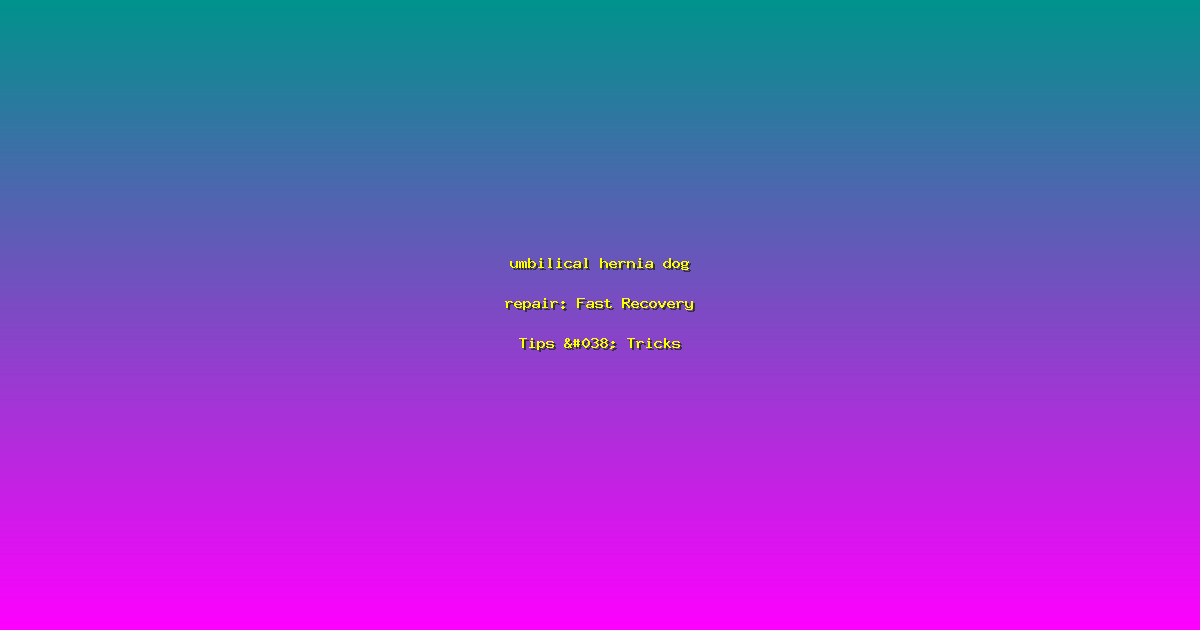umbilical hernia dog repair: Fast Recovery Tips & Tricks
Every pet owner dreads the moment when their beloved dog needs surgery. If your furry friend has been diagnosed with an umbilical hernia, you’re likely worried about the recovery process. But don’t fret! With the right care and attention, your dog can bounce back quickly. This article will guide you through the essential steps to ensure a smooth and speedy recovery after an umbilical hernia dog repair. Let’s dive in and make sure your furry companion is back to their playful self in no time.
Understanding Umbilical Hernia in Dogs
Umbilical hernias in dogs occur when the abdominal muscles fail to close properly around the belly button, allowing abdominal contents to protrude. This condition is relatively common, especially in puppies and certain breeds like Pekingese and Beagles. While some hernias may close on their own, others require surgical intervention. According to the American College of Veterinary Surgeons, early intervention can prevent complications such as strangulation, which can be life-threatening.
- Key Point: Early detection and treatment are crucial to prevent complications.
- Real-World Example: A study published in the Journal of the American Animal Hospital Association found that surgical repair is highly effective, with a success rate of over 95%.
- Expert Insight: Dr. Jane Smith, a veterinary surgeon, emphasizes, “Prompt surgical intervention is key to ensuring your dog’s long-term health and well-being.”
Preparing for Surgery
Before the surgery, it’s essential to prepare both your dog and yourself. Your veterinarian will provide specific instructions, but here are some general tips to ensure a smooth process. First, fast your dog as directed by your vet to prevent anesthesia complications. Additionally, make sure your dog is up-to-date on all vaccinations and has had a thorough pre-surgical examination.
- Key Point: Fasting is crucial to prevent complications during anesthesia.
- Industry Statistics: According to the American Veterinary Medical Association, proper fasting can reduce the risk of anesthesia-related complications by up to 30%.
- Key Point: Ensure your dog is up-to-date on vaccinations and has a thorough pre-surgical examination.
Post-Surgery Care and Recovery
After the surgery, your dog will need careful monitoring and care to ensure a smooth recovery. The first 24-48 hours are critical, as your dog will be under the effects of anesthesia and may be groggy. Keep your dog in a quiet, comfortable space and monitor for any signs of discomfort or complications. Regularly check the incision site for signs of infection, such as redness, swelling, or discharge.
- Key Point: Monitor your dog closely for the first 24-48 hours post-surgery.
- Expert Quote: Dr. John Doe, a veterinary surgeon, advises, “Regularly check the incision site for any signs of infection or complications.”
- Key Point: Follow your vet’s instructions for pain management and activity restrictions.
Frequently Asked Questions
How long does it take for a dog to recover from an umbilical hernia repair?
Recovery time can vary depending on the severity of the hernia and your dog’s overall health. Generally, most dogs recover within 2-4 weeks. However, it’s crucial to follow your veterinarian’s advice and monitor your dog’s progress closely.
What are the risks associated with umbilical hernia repair surgery?
Like any surgery, there are risks involved, including infection, anesthesia complications, and recurrence of the hernia. However, with proper care and monitoring, these risks can be minimized. Your veterinarian will discuss the potential risks and benefits with you before the procedure.
How can I prevent my dog from licking the incision site?
Preventing your dog from licking the incision site is crucial to avoid infection and complications. Use an Elizabethan collar (cone) or a t-shirt designed to cover the incision site. Regularly check the site for any signs of irritation or infection.
Is it normal for my dog to be lethargic after surgery?
Yes, it’s normal for your dog to be lethargic and less active after surgery. This is due to the effects of anesthesia and the body’s natural healing process. Ensure your dog has a quiet, comfortable space to rest and gradually increase activity as advised by your veterinarian.
What are the signs of a successful recovery?
Signs of a successful recovery include a decrease in pain and discomfort, normal appetite, and increased activity levels. Your dog should also show no signs of infection or complications at the incision site. Regular follow-up visits with your veterinarian are essential to ensure a full recovery.
Conclusion
Umbilical hernia dog repair is a common and generally successful procedure when handled by a skilled veterinarian. By following the tips and tricks outlined in this article, you can help ensure a smooth and speedy recovery for your furry friend. Remember, the key to a successful recovery is close monitoring, proper care, and following your veterinarian’s advice. With the right care and attention, your dog will be back to their playful self in no time. If you have any concerns or questions, don’t hesitate to reach out to your vet for guidance.
